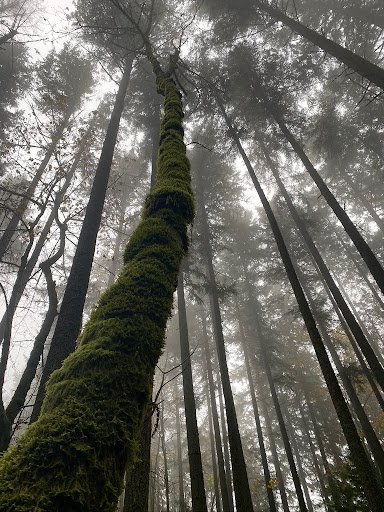De Leo Wall: A Seattle-Area Ecological Gem Facing Challenges
By Svet Semov, Vice President, Issaquah Alps Trails Club
Just outside Seattle lies one of the largest conserved wildland areas near any major U.S. metro, thanks to decades of advocacy by the Issaquah Alps Trails Club. Cougar Mountain is the closest part of the Issaquah Alps to Seattle. On its south side lies De Leo Wall, an ecologically sensitive gem that supports a rich natural habitat benefitting bald eagles, chinook and coho salmon, and other wildlife. It also has a long tradition of informal hiking. However, potential logging plans pose a threat to its ecological balance leading to complex land management challenges.
Photo courtesy of Svet Semov.
An Ecosystem on the Edge
De Leo Wall is a striking 900-foot hillside featuring some of the highest density of conifers on Cougar Mountain, its nearly vertical face offering beautiful views of Newcastle. Small streams run through the De Leo Wall area into the May Creek Basin, which drains to Lake Washington. The basin has long been prone to flooding, prompting Newcastle, Renton, King County, and the Washington Department of Natural Resources to work on solutions since 2001.
Despite these efforts, potential logging plans for De Leo Wall threaten to upset its delicate balance. The forest’s roots and soil play a crucial role in slowing rainfall, allowing water to soak in gradually, reducing erosion, and preventing floods downstream. In addition to flood control, this forest supports chinook and coho salmon in the May Creek Basin and provides nesting and shelter for bald eagles and other wildlife.
From ‘Informal’ Hiking to Community Effort
Since the 1970s De Leo Wall has been a beloved hiking spot for Seattle-area hiking enthusiasts. Over the decades it has maintained a unique charm with its narrow trails lined with exposed roots, steep ledges, and a higher density of Madrona trees thriving in the drier conditions. This distinctive charm often means that the trails are more secluded offering hikers a peaceful retreat.
Photo courtesy of Svet Semov.
However, this beloved area is situated on private property, and in 2018 the property owner applied for a logging permit to clear cut the area raising concerns for the potential ecological impact. This prompted local hikers and community members to unite leading to the formation of the Save De Leo Wall campaign. As the campaign gained momentum more than 140 people attended the Newcastle City Council meeting in May 2019 to speak against the proposed logging.
The Save De Leo Wall campaign illustrates how hiking and a direct experience of nature can foster a deeper conservation ethic, reflecting the IATC’s tradition of inspiring stewardship through meaningful connections with the outdoors.
Complex Land Stewardship
De Leo Wall stands at the intersection of private ownership and regional conservation highlighting the complexity of land management in the area. Located adjacent to Cougar Mountain Regional Wildland Park, managed by King County, and within the City of Newcastle, this area exemplifies the intricate coordination required between many local stakeholders. In this complex landscape, ongoing collaboration remains key to preserving De Leo Wall’s ecological and community value.



